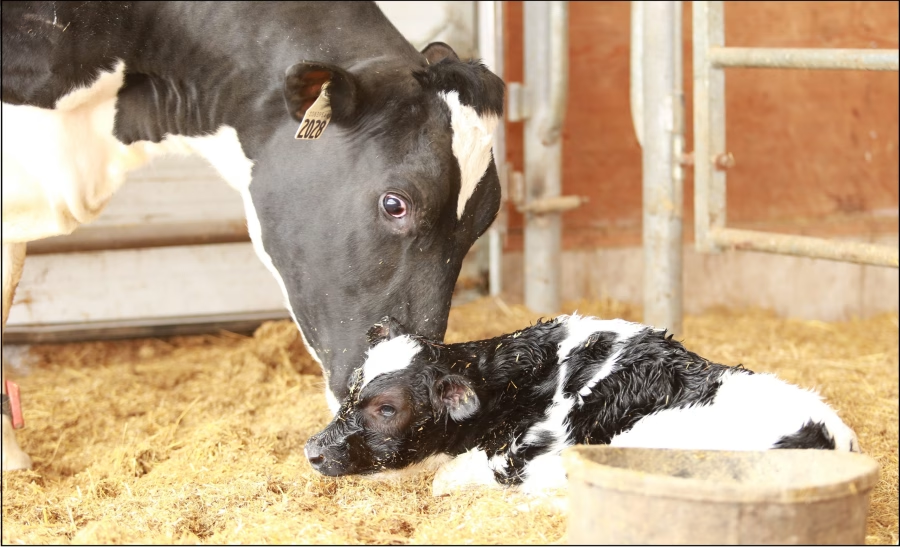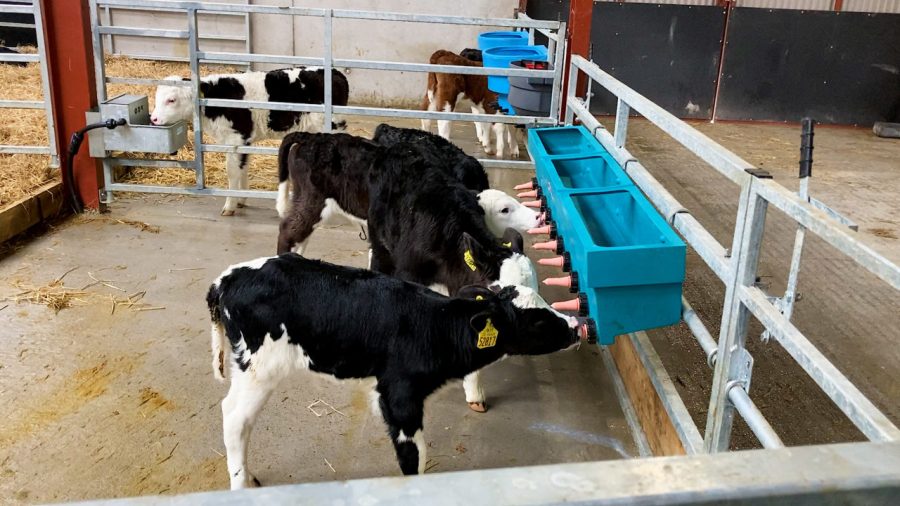Unlock the secrets to exceptional colostrum feeding for dairy calves with these four golden rules. Aim for healthier, more resilient calves by mastering these critical steps and providing them with the best possible start in life.
Ensuring newborn dairy calves receive proper nutrition is paramount for their health and development. At the cornerstone of this critical period lies colostrum feeding, which demands precise attention to various facets to optimize its benefits. This article will delve into the four golden rules that every dairy farmer should follow:
- Quality of Colostrum
- Quantity of Colostrum
- Timing of Colostrum Feeding
- Cleanliness and Storage of Colostrum
By adhering to these fundamental principles, you are not only ensuring the health and vitality of your calves but also setting a robust foundation for their future growth and productivity. These rules are the key to markedly improving the health outcomes and overall vitality of your calves, which in turn directly impacts the productivity and sustainability of your dairy business.
Why do newborn calves need colostrum?
For dairy producers, ensuring the health and vitality of newborn calves is a top priority, as the future output of their herds hinges on the first treatment these young animals receive. The first milk the cow produces upon birth, colostrum, is a powerhouse of immunity and nourishment, packed with growth hormones, vital minerals, and antibodies. The meticulous management of colostrum, led by dairy producers, directly and significantly impacts the productivity and sustainability of the dairy business.
- Rich in Antibodies: Packed with IgG immunoglobulins to protect against pathogens.
- Nutrient Dense: Contains higher fat, protein, vitamins, and minerals than regular milk.
- Growth Factors: Supplies hormones and bioactive molecules for gut development and nutrient absorption.
- Gut Health: Provides beneficial microbes and promotes gut health, preventing early digestive diseases.
The First Golden Rule: Quality of Colostrum
| Colostrum Quality Indicator | Optimal Value |
|---|---|
| Immunoglobulin G (IgG) Concentration | > 50 mg/mL |
| Bacterial Count | < 100,000 CFU/mL |
| Specific Gravity | > 1.050 |
| Total Solids | > 22% |
| Harvest Time Post-Calving | Within 2 hours |
In the complex field of dairy farming, good colostrum feeding starts the process of maintaining the health of newborn calves. Emphasizing the first golden rule, which focuses on the crucial antibody concentration—especially Immunoglobulin G (IgG)-is paramount. Passive immunity depends on IgG, which helps early-day calves fight infections. Thus, it is non-negotiable to guarantee a good colostrum, underscoring the urgency and significance of this task for dairy producers.
Quality colostrum should have more than 50 mg/ml of IgG to provide enough immunity. Reaching this calls for both exact instruments and regular observation. The colorimeter and the Brix refractometer are two primary devices used to evaluate colostrum quality. While the Brix refractometer gauges the sugar content related to IgG levels, a colorimeter determines IgG concentration by evaluating colostrum density. Usually indicating the intended 50 mg/ml IgG, a Brix measurement of about 22%
Colostrum quality goes beyond IgG levels and depends on many criteria. Colostrum should be collected two hours after calving. Antibody levels are influenced by the cow’s pathogen exposure, timing of vaccination, nutritional state, age, breed, and pathogen type. Keeping colostrum clean is essential, as bacterial contamination might impede IgG absorption. Helping to maintain quality involves sterilizing tools, cooling colostrum to 4°C if not consumed right away, and throwing away spoilt colostrum.
Regular evaluation and record-keeping are crucial. Monitoring colostrum quality helps maintain general herd health and guides cow management and sanitation policy choices. Treating colostrum quality calls for attentive recording, precise measuring equipment, and quick collection. The life and development of the calf depend on this investment in excellent colostrum, which also reflects the adage that an ounce of prevention is worth a pound of cure.
The Second Golden Rule is: The Quantity of Colostrum
Regarding the second golden rule—the quantity of colostrum—calves must have enough during the first several hours. A calf should generally eat about 10% of its body weight in colostrum throughout the first six hours. This level is vital for the calf’s immunity and survival.
| Calf Body Weight (lbs) | Colostrum Quantity (quarts) |
|---|---|
| 60 | 4-5 |
| 80 | 5-6 |
| 100 | 6-7 |
| 120 | 7-8 |
A calf’s digestive system is most open to colostrum just after delivery; it also contains immunoglobulins required for passive immunity. Calves must depend on colostrum because, unlike other animals, they do not get antibodies from the placenta. Early hours’ fast absorption is vital as delays can result in less-than-ideal immunity.
Calculating colostrum based on body weight guarantees customized feeding. A ninety-pound calf needs around nine pounds (four liters) of colostrum within six hours. Studies show that calves getting at least four liters of premium colostrum had lower morbidity and death rates and improved serum immunoglobulin levels.
Besides immunity, colostrum provides nutrients, hormones, and growth factors that help the gut expand and adaptably change metabolism. It also increases gastrointestinal motility, which helps the calf’s first stool—meconium—be expelled.
Effective control of colostrum volume is essential. Bottles, automatic feeders, or esophageal tube feeders should be used to give fresh colostrum or kept under ideal conditions.
Calf health and early growth generally depend on consuming around 10% of their body weight in colostrum within six hours. Following these guidelines can help improve calf health, resilience, and general herd performance.
The Third Golden Rule: Timing of Colostrum Feeding
The third golden rule, the ‘timing of colostrum feeding ‘, is paramount. The process of gut closure, where the calf loses its ability to absorb antibodies from colostrum, commences almost immediately after birth. Hence, the first colostrum feeding should occur within the first two hours of life to ensure optimal antibody absorption.
Colostrum supplies necessary immunoglobulins (IgG) for passive immunity. Research indicates postponing this initial meal affects general immunity and blood IgG levels. Timing is crucial, as Chigerwe et al. discovered that calves fed for two hours had greater blood IgG levels than those given six or twelve hours.
New dairy management techniques advise giving fresh, premium colostrum right after delivery. This guarantees strong antibody absorption by the calf’s intestinal cells. Complementing the first meal within 12 to 24 hours will boost immunity even more. In some fundamental sense, long-term health and productivity depend on early colostrum feeding.
| Time After Birth | Absorption Efficiency | Recommended Feeding Volume |
|---|---|---|
| <1 hour | Absorption at its peak (90-100%) | 10% of body weight |
| 1 – 2 hours | Very high absorption (70-90%) | 10% of body weight |
| 2 – 6 hours | High absorption (50-70%) | 10% of body weight |
| 6 – 12 hours | Moderate absorption (30-50%) | 10% of body weight |
| 12 – 24 hours | Low absorption (10-30%) | 10% of body weight |
| After 24 hours | Minimal to no absorption (<10%) | Continue feeding but expect reduced benefits |
Moreover, consistent colostrum feeding fits more general farm management strategies to maximize calf raising. Good timing helps to cut morbidity rates and veterinary expenses. Engaging farm staff guarantees calves get colostrum when most advantageous, stressing this preventive action.
Delays become wasted chances when significant proteins called colostral antibodies absorb less during the first several hours. Every hour without colostrum feeding reduces the calf’s ability to absorb these proteins, reducing first immunological competence.
Colostrum feeding time is thus significant. To enhance immunological effects, the first meal should occur two hours later, and the following meals should occur twenty-four hours later. This approach guarantees calves begin with robust immunological protection, enhancing health results.
Dairy producers must combine timing devices to simplify feeding, including calf monitoring and parturition data. This captures the core of best dairy production, ensuring every calf gets the immunological head start required for a strong and healthy life.
The Fourth Golden Rule: Cleanliness and Storage of Colostrum
| Aspect | Recommended Practice | Rationale |
|---|---|---|
| Collection Equipment | Sanitize before use | Prevents introduction of pathogens |
| Temperature for Storage | Refrigerate at 39.2°F (4°C) or lower | Slows bacterial growth |
| Freezing Colostrum | Freeze at -4°F (-20°C) | Preserves antibodies for up to a year |
| Thawing Colostrum | Thaw in warm water (110°F – 120°F or 43°C – 49°C) | Ensures even thawing and retains antibody integrity |
| Maximum Storage Duration | Refrigerated: Up to 7 days, Frozen: Up to 1 year | Ensures colostrum quality over time |
The fourth golden rule, ‘ cleanliness and storage of colostrum,’ is crucial to management. It underscores the need for proper handling and storage to maintain colostrum quality, which is essential for the health and development of calves. Maintaining colostrum’s quality and encouraging calf health depends on its being clean and properly stored. To avoid bacterial contamination, this procedure starts with hygienic, sterilized colostrum collecting, storage, and feeding equipment.
The cow’s udder should be cleaned and sanitized before milking to eliminate filth and reduce the microbial burden. Right now, cleanliness is highly influenced by colostrum quality.
Colostrum collected should be moved immediately to fresh containers. It should cool quickly to 100°F (37.5°C). Store short-term refrigerated between 33°F and 39°F (0.5°C and 4 °C) for up to 24 hours. Freeze colostrum either below 0°F (-18°C) or at 0°F longer term. Correct labeling of the cow’s health information and collecting data is vital.
Thaw frozen colostrum in warm water (between 110 and 120 degrees Fahrenheit; between 43 and 49 degrees Celsius). Avoid using microwaves to avoid damaging proteins.
It is also important to maintain cleanliness when feeding and traveling. Replace old equipment and routinely clean and sterilize all of your tools.
Teaching farm personnel hygienic practices for handling colostrum, including temperature control, is crucial. Thorough instruction should cover all facets of colostrum management, enhancing calf health.
Ultimately, calf health and vigor depend mainly on strict hygienic standards and careful temperature control in colostrum management.
The Bottom Line
Dairy calf health and growth depend on knowing and following the golden standards of colostrum feeding. Concentrating on quality, quantity, prompt administration, appropriate cleaning, and storage may significantly affect calf vitality and output. Scientific studies and field observations support these vital techniques, which underline the key function of colostrum in calf immunity and welfare.
Following these guidelines has dramatically lowered morbidity and death rates in young calves. Studies by Stott et al. and Thornhill et al. confirm that every element—from quality to cleanliness—offers necessary advantages that guarantee the best calf health.
Farmers, caregivers, and professionals are all responsible for regularly using these techniques. A calf’s early morning and day activities have long-lasting consequences. A commitment to colostrum management excellence will help guarantee better herds, more stable dairy output, and a more sustainable and profitable dairy business. The moment to act is right now; use these golden guidelines and see how your dairy operations and calves improve.
Ensuring newborn dairy calves receive proper nutrition, especially colostrum is crucial for their health and long-term productivity. Colostrum feeding sets the stage for robust growth and development. For more on developing an effective feeding plan, read Calf Rearing Excellence: Finding the Perfect Feeding Plan for Your Farm. Enhance calf health and performance with Top 5 Must-Have Tools for Effective Calf Health and Performance. Learn about early heifer development in From Calf Starter to TMR: The Key to Early Heifer Development.
Key Takeaways:
- Ensuring newborn calves receive high-quality colostrum is essential for their initial immune protection and overall health.
- It’s crucial to deliver an adequate quantity of colostrum, optimally around 10% of the calf’s body weight, to guarantee sufficient nutrient intake and antibody absorption.
- Timely administration of colostrum, ideally within the first two hours post-birth, maximizes the absorption of antibodies and boosts the calf’s immune defenses.
- Maintaining strict cleanliness and proper storage practices for colostrum preserves its nutritive value and prevents potential contamination, which could otherwise harm the calf’s health.













